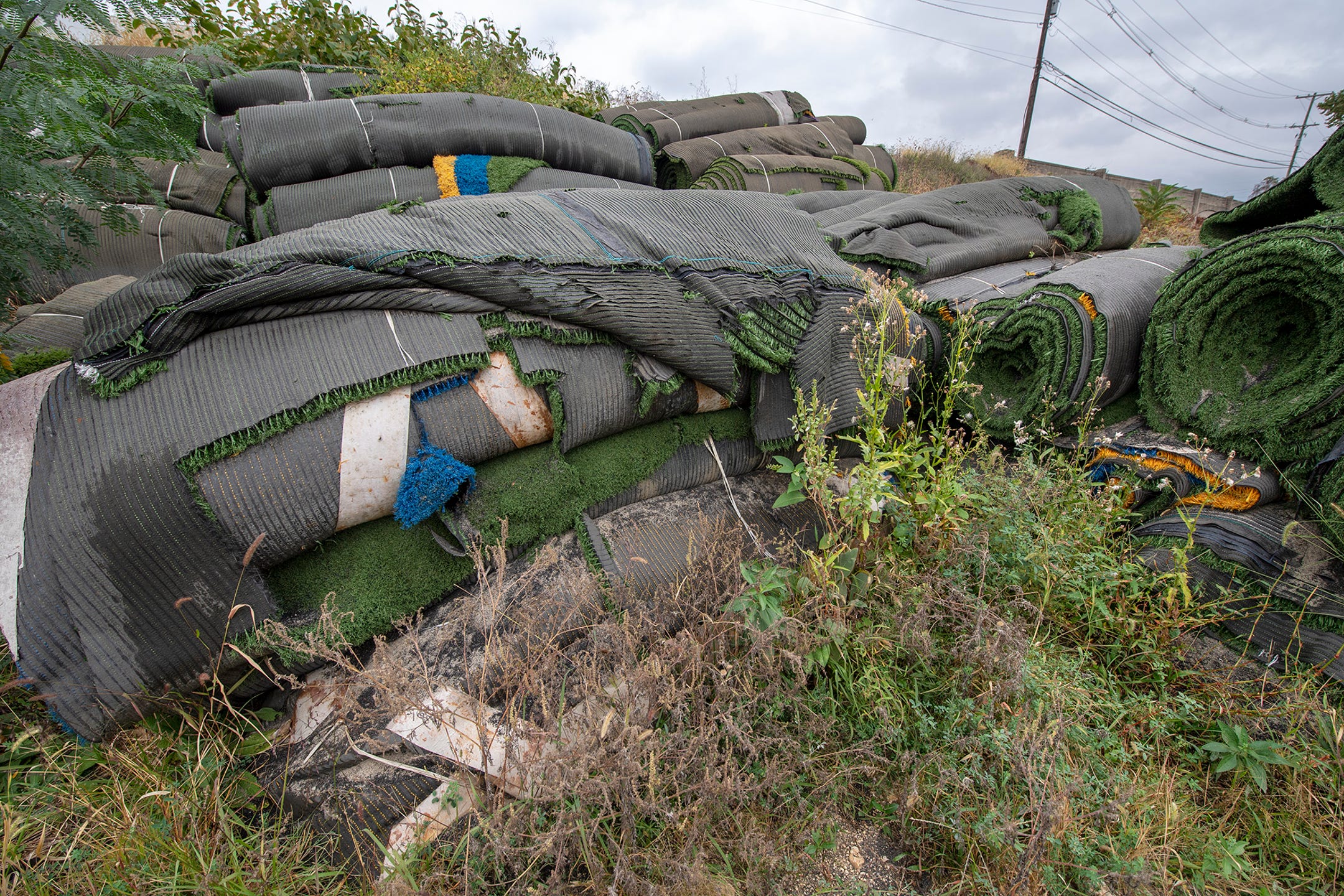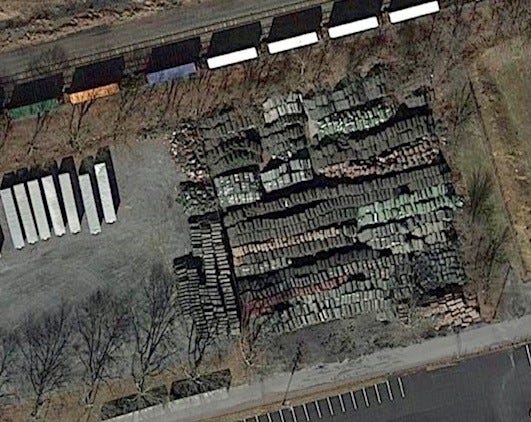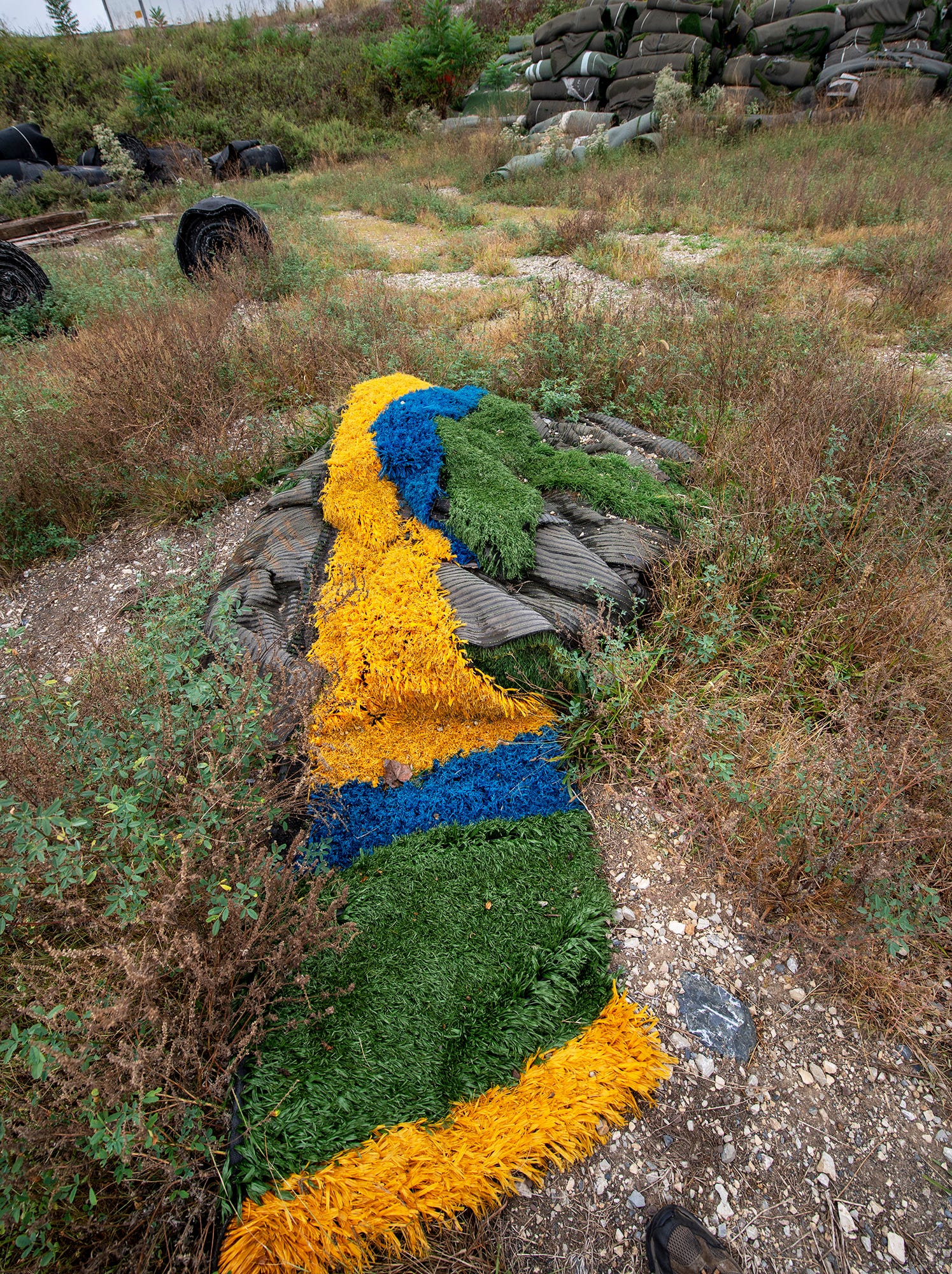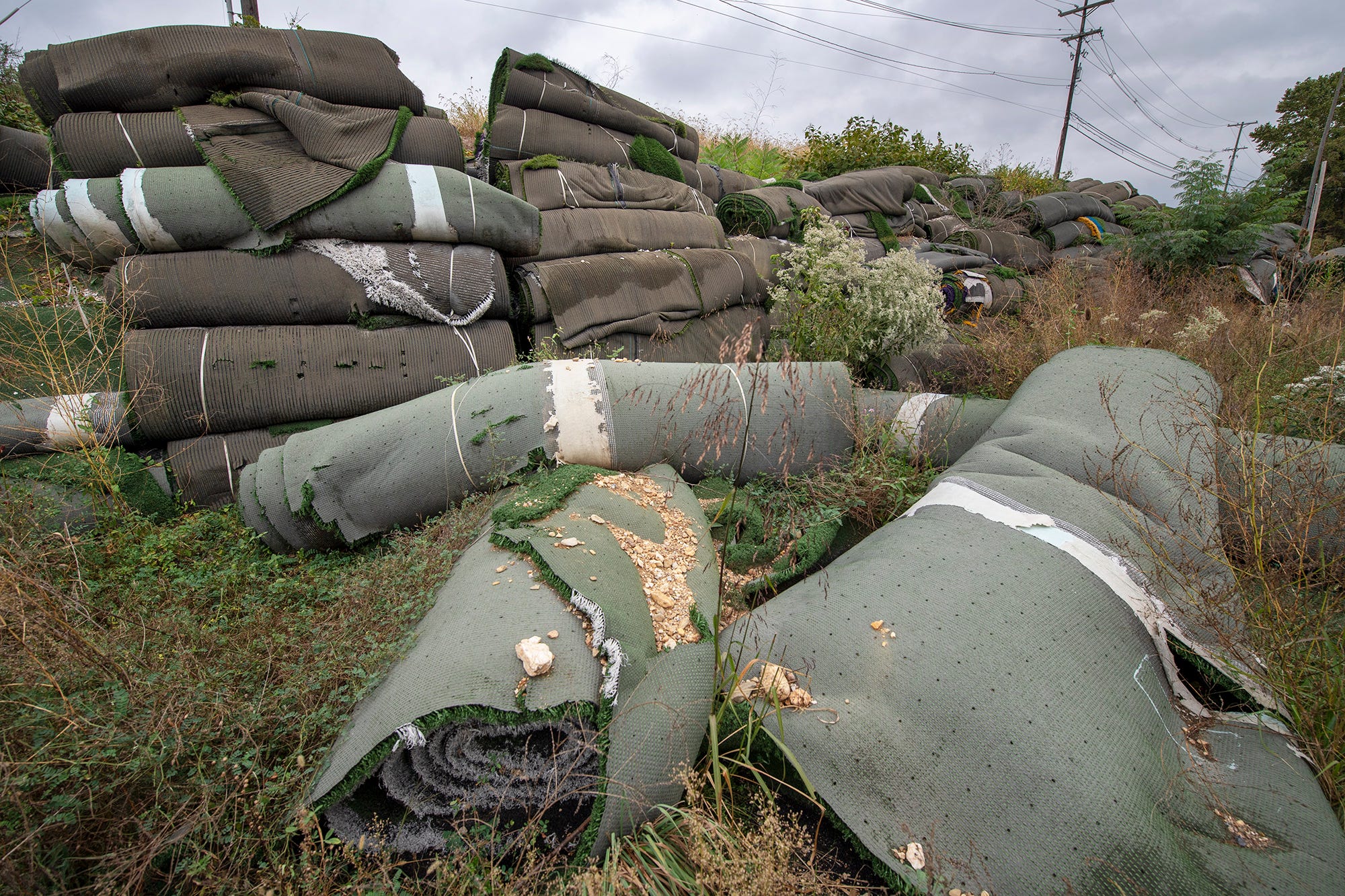
The hulking wall of rubber was first discovered by a borough maintenance crew.
About 6,000 rolled pieces were neatly stacked about 10 feet high, covering more than an acre of private land, according to the mayor of Cleona, Pennsylvania.
The green blades of artificial grass peeking through the coiled logs offered the first clue.
“This is what it looks like when someone gets rid of a dozen turf fields and there’s nowhere to send them,” said Mayor Larry Minnich.
A York Daily Record/York Sunday News investigation has found an unregulated industry that is growing exponentially and dumping several hundred old athletic fields across the U.S. every year.
Artificial turf and the projected mountains of waste
Used artificial turf is expected to produce 1 million to 4 million tons of waste in the next 10 years, and it has nowhere to go, according to solid waste industry analysts.
Minnich, the Cleona mayor, soon learned that the problem in his borough of about 2,100 people was similar to what communities were grappling with across the country — tons of worn-out, artificial school fields that municipal dumps won’t accept and a growing, unregulated, cottage industry of vacant land owners taking the waste.
Turf fields installed in waves a decade ago are reaching the end of their lifespan and need to be replaced, according to an industry trade association. Despite being touted as a completely recyclable alternative to grass, there are no companies in the U.S. that can completely recycle them, according to a trade association president.
The fields frequently end up in empty lots, backyards, in public spaces and on private land. Sometimes, they are given permission to be there. In some cases, they have been dumped illegally by contractors paid to remove them.
An inside look at the turf war
Artificial turf fields are largely made of scrap tires and synthetic fibers and are designed to look like natural grass. They’ve been revamped from the AstroTurf in the 1960s, which was largely made of fibers and sand, into the synthetic turf today that’s made of recycled rubber, fibers and sand.
There are about 12,000 to 15,000 turf fields in the United States, according to the Synthetic Turf Council. Most of those fields carry an eight-year warranty, which is standard across the industry. But the turf council’s top lobbyist says they can last 10 to 12 years.
When those fields reach the end of their lifespan, that waste has to go somewhere. But sending turf to a landfill is not cost effective or an industry best practice. Turf is already piling up on the sides of roads and being stored on private properties because there’s only one recycling facility in the world that can fully separate the parts for reuse, and that facility is in Denmark.
Some property owners are getting creative in how they reuse it, but disposed turf is outpacing demand. For now, some of these stacks are eyesores along highways that can last for decades.
Turf disposal is not regulated in Pennsylvania. These large piles of waste fall through bureaucratic cracks, leading to unchecked dumping. Though all waste in Pennsylvania requires a permit before being dumped, there are no specific rules on the books for turf. Those storing turf in Pennsylvania aren’t obtaining permits. They are cutting deals with landowners to store their waste, creating makeshift garbage dumps.
Without any rules or oversight, disposed turf becomes the burden and responsibility of anyone who lives around it.
Obstacles reusing and disposing of turf
Recently in Massachusetts and Washington, D.C., turf fields have tested positive for lead and toxins that are known to cause cancer, low birth weight in babies and other diseases, according to reports in the Boston Globe and Washington Post.
Industry-funded studies found no increased risk of disease to anyone of any age who uses turf fields.
There’s been no independent, definitive study on the safety of turf. The Obama Administration started to examine the issue in his second term. The Trump Administration has studied it for three years and on July 25 released the first part of its findings.
Some materials used to make turf fields, such as industrial silica sand, can’t be incinerated.
Sometimes, college and professional fields can be donated to other facilities, but youth fields are too worn to be donated to another facility.
Because stagnant water can pool inside them and attract rodents and mosquitoes, used tires can’t be taken to landfills. But turf, despite being largely made from old tires, can be taken to landfills. However, that’s an expensive option.
Pennsylvania law also cites that tires shouldn't be disposed of in landfills because they take up too much room.
It’s $60 to $70 a ton to dispose of turf in a landfill. Each roll of turf is about 2,000 to 3,000 pounds. A ton is 2,000 pounds. For the 6,000 rolls of turf in Cleona, the landfill option would cost about $400,000.
But none of those rolls are headed to a dump. They’re headed to Denmark. Slowly.
'We're running out of room'
The rolls have been sitting in Cleona for two years, and a few months ago, Minnich decided that was long enough. He was getting complaints from people in town, and there were safety concerns about the pile’s flammability and proximity to a fueling station.
Property owner Kevin Fox, who operates a transportation business, said he never had any safety concerns, especially because the rolls were stored inside a fenced-in lot.

Fox has been storing the turf for an undisclosed property rental fee since a former business associate told him more than a year ago that a turf recycler overseas needed a place to store dismantled fields.
But Fox also reached a point where he agreed with the mayor that the turf couldn’t stay on his property.
“We were running out of room,” Fox said.
Challenges after inheriting abandoned turf
At another site, weeds push through rolls of turf that are scattered on a hillside at the intersection of Matthew Bupp’s property at Loucks Mill Road and Route 30 in York, Pennsylvania.
People frequently drive by and ask a version of: “What is that?”
Bupp knows the feeling.
He wondered the same thing when he inherited the problem a couple of years ago.
Somebody who leased the land to store the turf defaulted on the rent. He’s not sure of the contractor, but he knows the disposed field was trucked in from Harrisburg or Mechanicsburg, 40 miles away.
“It feels like this old football field has been here forever,” he said. “Promising rent and then abandoning the material is a perfect way of making sure you have no disposal costs and then making disposal someone else’s problem.”
It feels like this old football field has been here forever.
Bupp said there were so many subcontractors involved that he couldn't successfully figure out the right person to hold accountable.
The turf is not easy to get rid of. In addition to the high costs involved, it’s physically daunting. Each roll, depending on the size, typically weighs between 900 and 3,000 pounds.
“This isn’t something you can put on the back of a pickup truck. You need tractor-trailers and machinery to lift it,” Bupp said.
'One man's trash is another man's treasure'
He decided to get creative. He advertised through Craigslist and word of mouth, transferring the turf roll by roll to new homes and businesses.
“Some has been given away; some has been sold. But I didn’t plan on or want to go into the turf business,” said Bupp, a property developer.
The divvied up turf is now at a community garden in York City, indoor Xtreme Archery in Springettsbury Township, local soccer organizations, a Maryland lacrosse team, batting cages and private lawns for weddings. He’s also sent some of the rubber to a private home to be placed under a water slide.
“I’m trying to make the old adage true that one man’s trash is another man’s treasure,” Bupp said. “I’m finding waste and putting it to reuse.”
He’s an environmentalist at heart. When he bought the property five years ago, he said, he cleaned up 256 tires and two abandoned cars that were dumped and deserted on the bank of the nearby Codorus Creek.
“I’ve always said real men recycle, but now I’d say real people recycle,” Bupp said. “I’m not sure how much longer it will take to get rid of it all, but I know it can be recycled and repurposed.”
Unregulated, untraced
Too often, old turf fields are not recycled and repurposed, according to Kyla Bennett, science and policy director of Public Employees for Environmental Responsibility.
She is also the director of the New England office for the watchdog organization, which helps government whistleblowers expose environmental wrongdoing.
Bennett said state and federal clients have reported that most turf fields typically go to landfills or are dumped illegally.
“They usually show up near wetlands or streams,” she said.
That's a concern because turf fields are largely made of crumb rubber, which is scrap tires. Scrap tires shouldn't be dumped near or in waterways because they pose two health threats: a safe haven for pests and fire risk, according to the U.S. Environmental Protection Agency.
"Prone to heat retention, tires in stockpiles also can ignite, creating tire fires that are difficult to extinguish and can burn for months, generating unhealthy smoke and toxic oils," according to the EPA.
Dan Bond, president of the Synthetic Turf Council, a Fairfax, Virginia-based trade group, said disposal of turf in waterways was a bad practice of the industry’s past.
“It used to happen in the '80s and '90s before recycling. Yes, that did happen, but our trade group is emphatic about best practices today, and our manufacturers and recyclers adhere to it,” Bond said.
But it’s not the manufacturers or recyclers he lobbies for who are removing the fields when they need to be replaced every eight to 10 years.
It’s usually a subcontractor who shows up to remove a field and dispose it. Sometimes, two different businesses are hired to remove a field and get rid of it. There’s no chain of custody. There are no regulations at state and federal levels on turf disposal.

For example, in Pennsylvania: “There are no waste regulations specific to turf, but the used turf would be considered waste, and should be managed as such. All waste disposal activities in Pennsylvania require a permit,” said Elizabeth Rementer, press secretary for the Pennsylvania Department of Environmental Protection.
A chain of custody can be difficult to follow because old turf can find multiple new uses, and industry lobbyists discourage regulations, Bond said.
“If you put out regulations on what to do at the end of a field’s life, that doesn’t help because there are so many applications. You can use different parts of the field for different applications. There’s not one best way to do this,” he said.
The industry can regulate itself by setting guidelines and best practices, Bond said.
His trade group recommends giving municipalities and school districts tax breaks for finding beneficial reuses for turf.
That’s not good enough for Bennett, who said it’s a scheme that “kicks the can down the road and distributes the problem to someone else.”
Concerns about chemicals found in artificial turf
Bennett said the best solution is to use natural grass.
Turf fields are a creative way for the tire industry to get rid of their waste, she said. The tires are shredded and put into fields, and eight to 10 years later, “a municipality then has to figure out what to do with it,” Bennett said.
Even worse, she said, the “consumer and end user have no idea what’s in it.”
It’s a problem for everybody.
Whistleblowers who work with PEER have raised concerns about the toxicity of the disposed fields that frequently get dumped on land near community water supplies, she said.
“It’s a problem for everybody,” Bennett said.
Bond said 110 industry studies found no increased risk of disease to anyone of any age who uses turf fields. He points to the studies on the trade association website.
In its first report about crumb-rubber synthetic fields, the U.S. Environmental Protection Agency and the Agency for Toxic Substances and Disease Registry said research was “inconclusive” on the safety of crumb-rubber fields.
They found a range of metals and chemicals in turf fields.
“While chemicals are present as expected in the (tire) crumb rubber, human exposure appears to be limited based on what is released into air or simulated biological fluids,” the report says.
The 800-page report looked at what chemicals are present in the fields, but it didn’t study whether those chemicals are safe for the people using them.
It is unclear when the second part of the federal study will be released.
A study by the Washington State Department of Health in 2017 found no evidence that crumb rubber in turf fields contained enough cancer-causing chemicals to put players at risk.
California is conducting its own study on turf fields, and the Consumer Product Safety Commission is studying children’s exposure to chemicals on rubber tire surfaces at playgrounds.
Growing cycle of installing, removing of turf fields
Used artificial turf is expected to produce 1 million to 4 million tons of waste in the next 10 years.
In the meantime, the number of new turf fields being installed and old ones being removed is growing every year in the multi-billion industry.
There are between 12,000 and 15,000 turf fields in the U.S., Bond said, and another 1,200 and 1,500 are opening each year.
Meanwhile, the number of disposed fields has grown from 365 in 2013 to 750 in 2018. The number of disposed turf fields is expected to grow by hundreds this year and in the upcoming year, according to the trade association.
And something that both the industry and environmentalists agree on is that they need somewhere to put them.
An apparent solution, hampered by a lack of oversight
The solution to the old turf problem might be found in the pipeline from Cleona to Denmark.
Fox, the property owner with thousands of rolls of turf on his property, is shipping dozens of loads at a time to Re-Match, a Scandanavian company that the industry and environmentalists agree is the only true recycling facility in the world.
But founder Dennis Anderson said his company is a solution few U.S. companies are using, mainly because there are no regulations that require fields to be recycled.
It costs about $20,000 to ship one field overseas and be recycled at Re-Match he said. That’s cheaper than a landfill. But if a contractor can pay a landowner a little bit of money to store turf, they will probably choose that option over shipping to Denmark, Anderson said.

Anderson's company is paying Fox an undisclosed amount to keep the fields on his property until it can open two U.S. recycling facilities in Pennsylvania and California in 2020. He did not disclose specific locations, but he said his company is in position to open the facilities late next year. It would take each recycling facility nine months to become operational.
His recycling method is patented in 56 countries and is the only one that completely separates the grass part of the turf from the crumb rubber part, he said. Re-Match is the only company that has the technology to recycle an old turf field into a new one, Anderson said.
Anderson has been storing 10 to 15 fields in Cleona while he works on opening a new facility in the Netherlands to serve the growing European market, where there are 4,100 new turf fields per year.
The European market also outpaces the U.S. market on regulations and has stricter requirements on recycling.
'Make it all go away'
Cleona didn't have any regulations on the books, either, but the mayor pressured Re-Match to remove the turf from the borough. Anderson flew to Pennsylvania to meet with him.
“I told them to take it away. Make it all go away,” Minnich said in the summer. “They did a little bit, but not to the level I was happy about. We’re hoping to get all of it out before winter sets in. That’s the plan as of today.”
Fox said he’s already shipped 25 loads to Denmark. He’s also shipped two or three loads to Playing Surface Solutions in Meadville, Pennsylvania, where the turf installer can partially recycle some of the materials and repurpose them as putting greens.
He was expecting to have more turf hauled away from his property in late November.
“To the average person, this is garbage. But for a company that knows how to do it, there’s hundreds of thousands in profit to separate and clean it and resell it. You have to have the right equipment to do it though,” Fox said.
Anderson has that equipment at Re-Match, but he doesn’t have enough U.S. business.
Bond said: “I think you’ll see more companies like Re-Match coming into the marketplace, and they are needed.”
While there are opportunities to recycle turf in creative ways, such as what Bupp is doing in York, the market is saturated with more old turf than there is demand for new putting greens or other alternative uses.
And, for now, industry leaders and environmentalists agree the best solution to getting rid of all the turf piling up is still an ocean away.
